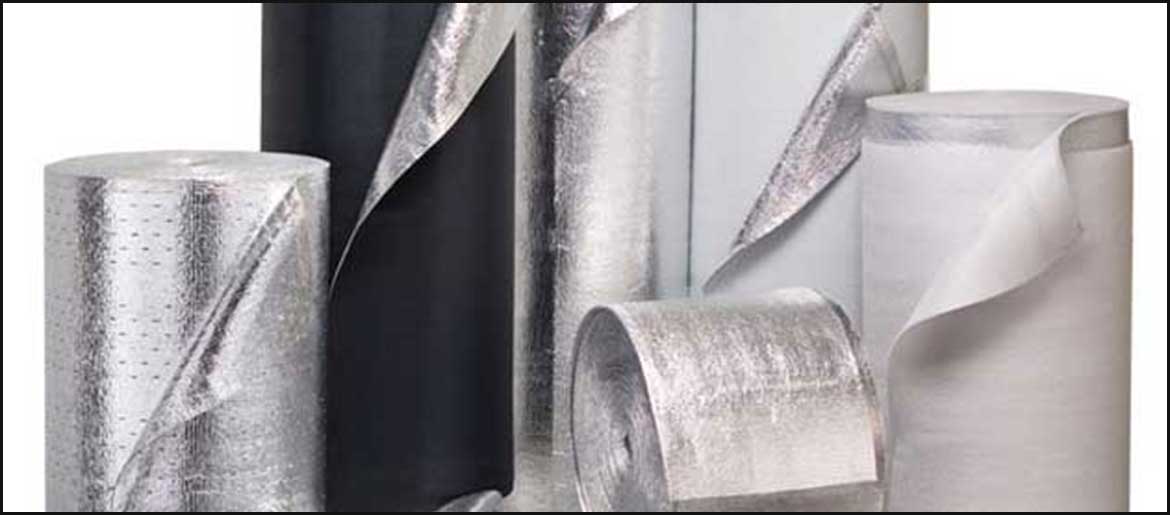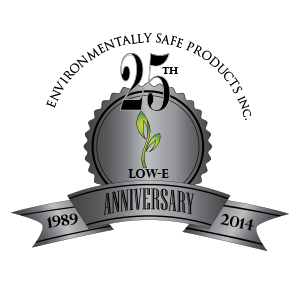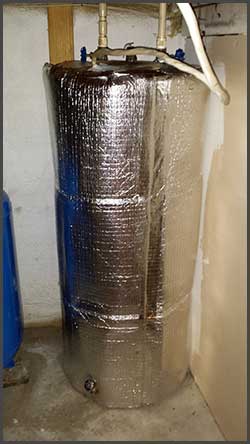


Environmentally Safe Products from New Oxford, Pa. manufactures Low-E™ insulation. This is the highest quality reflective insulation on the market today. The foil finishes are 99.4% polished aluminum (not to be mistaken by the metalized finish on competitors products called Mylar) with a polyethylene core of closed cell microscopic air bubbles. The patented process used to flame laminate the foil to the foam is done so that no glues are used in the manufacturing process. Low-E has the largest variety of products, sizes (12", 16", 18", 24", 4 ft, 5 ft, 6ft) and finishes available (foil and white foil) in the industry making it the #1 reflective insulation today.
All ESP® Low-E products have a Class A Class 1 Fire/Smoke rating unless otherwise noted on labels/brochures.
The key is the 99.4% polished aluminum facings on the product. Low-E™ stops 97% of radiant energy that it encounters from passing through the product. By allowing ONLY 3% of radiant energy to pass through, you will see noticeable savings on your next heating and cooling bills. Low-E™ helps prevent radiant energy, which accounts for between 60% and 93% of heat gain/loss in/out of a home. Also, the closed-cell polyethylene foam acts a thermal brake, moisture barrier, and sound deadener.
Distribution of our product is through national and local lumbar yards; residential and commercial building suppliers; heating and plumbing wholesale. Check out our site to find a distributor near you.
Low-E™ Reflective Insulation meets current "green" standards in many ways, including but not limited to; increasing the thermal efficiency of the building envelope without increased space. Core material can be made from post and pre-consumer recycled goods. Air infiltration barrier reduces gaps and leaks; which accounts for between 25-40 percent of the energy used for heating and cooling in a typical residence. The product does not promote mold or fungus growth, which contributes to safety and peace of mind. It can easily add energy savings to new or existing buildings. No airborne fibers or particulates will degrade your air quality, making it safe for installers and occupants.
Years ago, there were products used on the exterior of homes that stored radiant energy. Because of this heat storage, siding started to warp over a period of time. Unlike Low-E™ HouseWrap with a 99.4% polished aluminum facing, it reflects 97% of the radiant energy from the sun from entering the building envelope thus keeping your home much cooler. Low-E™ HouseWrap does not store heat and has been approved by most major siding companies, today, as it does not violate their respective warranties. Products with tin holds heat and there for can superheat. Low-E™ acts as a thermal break and reflects heat; does not store it.
Low-E™ HouseWrap meets the perm rating (breath ability requirements) as per ASTM E-96:4.65, but the unprecedented advantage of Low-E™ HouseWrap is an additional R-Value of 4.17. Stated R-Values for a specific application are based on the same testing methods as other insulations, and Low-E™ HouseWrap is an ICC approved weather resistive barrier. Other house wraps give you a breathable barrier only with no insulation value. Low-E™ HouseWrap also meets code. With Low-E™ HouseWrap there is no need to do two runs (fanfold/tyvec). With our housewrap it also prevents needing to do 2x6 construction.
Yes, the addition of Low-E™ insulation in new construction or an existing home will help to cool an attic space quickly, and depending on how widely it is installed in the home, keep it comfortable year round. Low-E™ offers multiple solutions based on insulation location or specified design need. For instance, installing Low-E™ Attic Floor insulation will help reduce heat gain into the building's conditioned space while allowing moisture to escape through the roof vent or soffits. It will also make the mass insulation you already have work better since it will not have to absorb so much heat in the summer. The insulation reflects 97% of radiant heat- the number one source of heat entering a home. In turn, Low-E™ Insulation creates a thermal break that will also keep house warmer in winter by helping keep heat in the conditioned living space. Please click on our Applications page HERE to see all the different products available to use in the attic and around the home to keep it cooler.
If your attic floor is open, you can lay the Low-E™ Attic Floor insulation right across the top of your existing insulation, and this will stop 97% of the radiant energy from passing down into your conditioned space. The Low-E™ Attic Floor insulation is perforated (breathable) which prevents moisture from being trapped. For many owners of older homes, they feel a large temperature change between the upstairs and downstairs in the summer-especially in the afternoon. The sun's radiant energy is passing through the roof and the mass insulation slowly stores the heat which eventually transfers down to the conditioned space causing heat gain. This makes your air conditioner work harder to cool the conditioned space. In many homes, the afternoon heat proves difficult for the air conditioner to keep a constant temperature and the temperature increases upstairs. As stated earlier, with the installation of Low-E™ Attic Floor insulation, the heat gain will not be as severe since 97% of the radiant heat will be reflected and lower cooling cost may result. In the winter time, the Low-E™ Attic Floor insulation will slow down the heat loss from the home through your attic.

Yes! In each Low-E™ Hot Water Heater Jacket Kit there is an Instruction Manual that spells out how to install on either a gas or electric. Each wrap comes with enough material to cover the largest hot water tank along with spacers and tape.
Low-E™ HVAC is fine for a condition area giving you a R-6.41 with proper spacers installed. Class A Class 1 Fire Rating, superior thermal performance and reduces condensation. You will have to go R-8 to meet code in an unconditioned area (cold basement or attic area etc.).
There are many types of construction methods that could be addressed here with the installation of metal and these vary from the northern climate to the southern climate. Typically, we are not looking for R-Value per say in a roof system and it is there that I would recommend using our Low-E™ Micro, which is 1/8" thick product. This will give you the vapor barrier that you are looking for and also stop 97% of the radiant energy from passing into the building envelope. Additionally, you will pick up an R-Value of 10.24 and again this product has a Class A Class 1 Fire Rating. As with all Low-E™ insulation, by running any fasteners through the product, the composition of microscopic air bubbles will self-seal back around the fastener. For agriculture use we have a Class A White. When ceilings are exposed to the rafters, this is the desirable product to use. The foil would go toward the metal roofing and the Class A White would be the bright finish that you would see from below.
The concrete will not affect the Low-E™ Slab Shield polyethylene closed cell foam. It does not matter which side is facing up; both sides are foam sandwiching aluminum. The 99.4% pure polished aluminum foil in Low-E™ Slab Shield is sandwiched in between two layers of closed cell foam. You will notice a tab on each side of the Low-E™ Slab Shield that will make it easy to install with one roll over lapping the other preventing the cement from touching the edge of the polished aluminum. This product is a complete vapor barrier and will not require any additional barrier. Low-E™ Slab Shield is extremely durable under the toughest conditions with a crush resistance of 70 and a puncture resistance of 93 psi. Builders appreciate the fact that Low-E™ Slab Shield does not crack like foam products used in similar wet concrete applications.
Installing Low-E™ HouseWrap over the exterior 1/2” sheathing (directly behind vinyl hollow back siding) and substituting R-15 fiberglass within the stud wall cavity will comply with the alternate U-factor option allowed by the 2012 IECC. This can be proven by the ResCheck program or a RESNET approved rater.
All reflective insulations achieve R-value by evaluating the core resistance of the material and the airspace facing their low emissivity foil facing. This is known as a system R-value. When evaluated behind hollow backed vinyl siding, Low-E™ HouseWrap has an R-value of 4. The Low-E™ HouseWrap Technical Manual has third party certified R and U-value data available for most siding applications.
No, the installation of Low-E™ will not melt your siding. It reflects 97% of the heat that was already present and thermal infrared studies show that there is a nominal 2 degree increase in temperature on the siding. All the major siding manufacturers affirm that Low-E™ will not invalidate their respective warranties.
No. Low-E™ HouseWrap is only 3/16” thick and requires no jamb extensions or trim modifications. This is a huge labor and material cost saver.
Standard button top fasteners are recommended. Also, per the International Code Council, all house wraps should have taped seams.
Low-E™ HouseWrap is installed horizontally like other house wraps. The foil flange is an edge overlap that lays over the trim edge of the run below it. This overlap serves as a drainage plain to prevent moisture from getting between seams.
The Energy Star New Homes Program Revision 7 does not specify the need for any house wrap. However, code in most areas does. That said, the Low-E™ HouseWrap may help builders to comply with the Energy Star checklists- such as sealing the building envelop and reducing air changes per hour. In addition, the Low-E™ HouseWrap provides thermal performance to a wall system that can help builders meet Energy Star wall envelope requirements. Low-E™ HouseWrap has been incorporated into thousands of Energy Star Homes over the years.